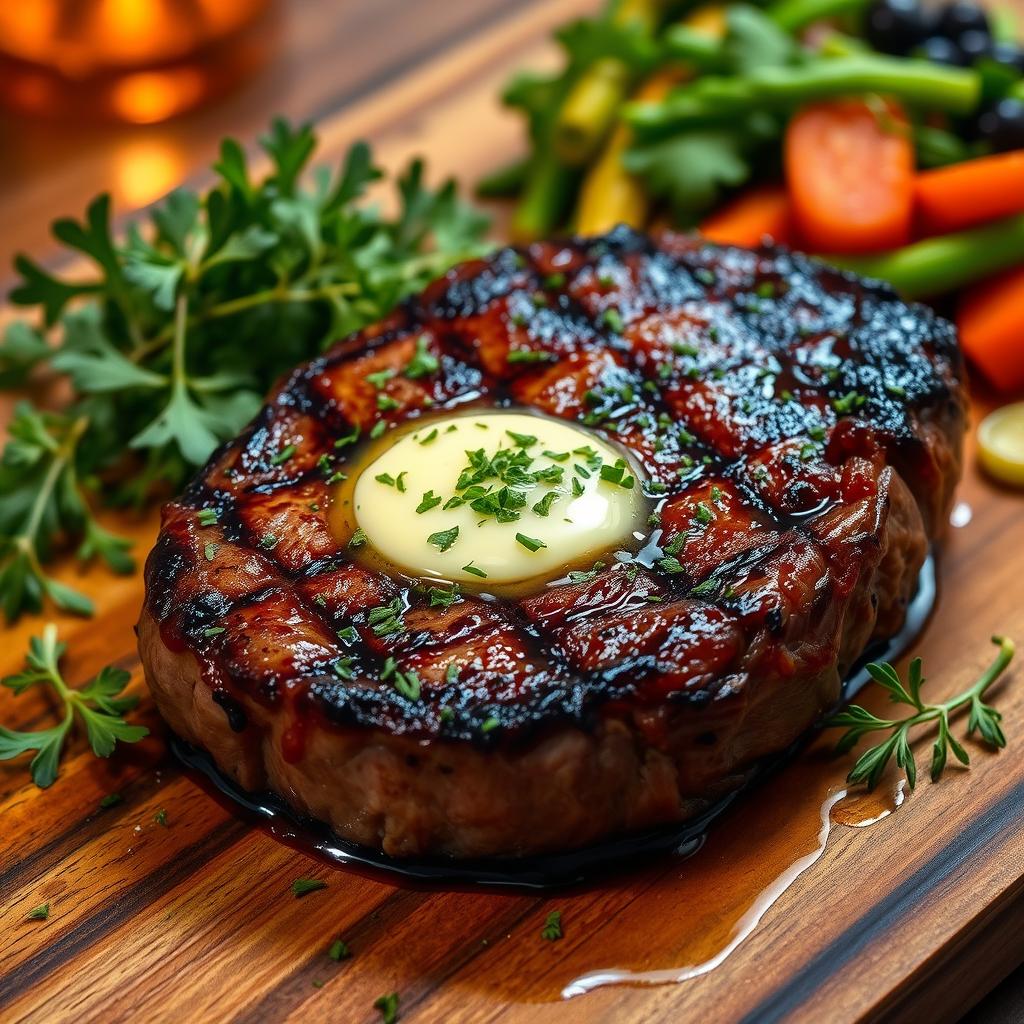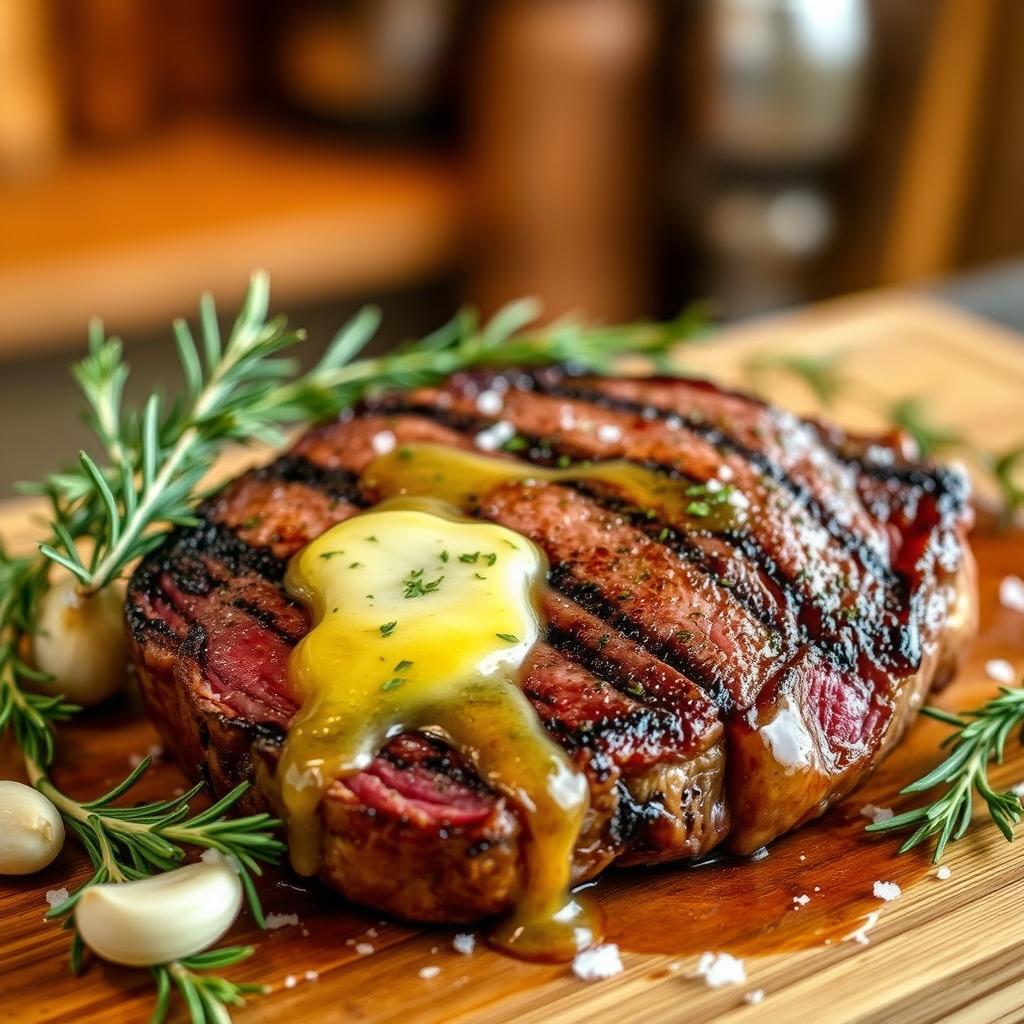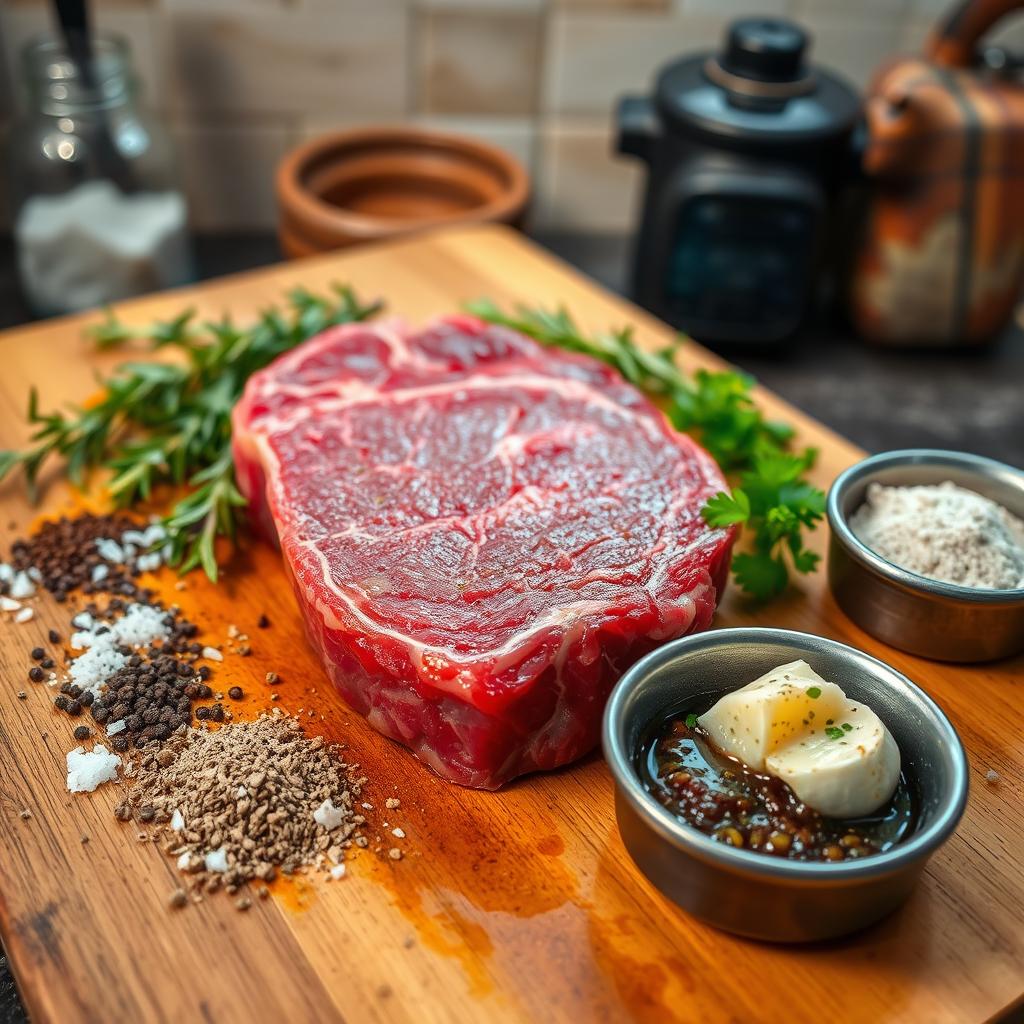There’s nothing quite like the mouthwatering aroma and sizzling sound of a perfectly pan-seared steak. As a self-proclaimed steak enthusiast, I’ve always been captivated by the art of crafting a restaurant-quality dish in the comfort of my own kitchen. The key? Mastering the art of pan-searing and pairing it with a heavenly herb butter that elevates the flavor profile to new heights.

Key Takeaways
- Pan-seared steak with herb butter is an indulgent, restaurant-style dish that can be prepared at home.
- The combination of a perfectly seared steak and flavorful herb butter creates an elevated dining experience.
- Choosing the right cut of meat and understanding steak grades and quality are crucial for achieving the ultimate sear.
- Properly seasoning and resting the steak are essential steps for maximizing tenderness and juiciness.
- The herb butter recipe and plating techniques can help you elevate your homemade steak to new levels of gourmet cooking.
The Art of Perfect Pan-Seared Steak
Getting a perfectly seared steak at home is a real treat. It’s all about picking the right meat, using the right tools, and knowing the grading. Whether you choose a juicy ribeye or a versatile New York strip, the cut makes a big difference.
Choosing the Right Cut of Meat
Ribeye and New York strip are top picks for pan-searing. They have great marbling and flavor. The ribeye is rich and tender, while the New York strip is leaner but chewier. Both offer a great dining experience with the right cooking.
Essential Equipment for Steak Searing
A cast-iron skillet is the best for searing steaks. It heats evenly, creating a crispy crust on the outside and keeping the inside juicy. Whether you’re cooking a ribeye or a New York strip, a cast-iron skillet is a must-have.
Understanding Steak Grades and Quality
The USDA grading system shows meat quality, with Prime being the best. Prime beef has the most marbling, making it tender and flavorful. Knowing these grades helps you pick the perfect steak for your dish.
“The secret to a perfect pan-seared steak lies in the quality of the meat and the precision of the cooking process.”
Preparing Your Steak for Cooking Success
Learning how to prepare steak is key to cooking a juicy, flavorful pan-seared steak. The first step is to let the steak come to room temperature before cooking. This helps it cook evenly.
Then, use paper towels to pat the steak dry well. Removing extra moisture helps it sear better and get a golden-brown crust. After that, season the steak generously with kosher salt and black pepper. This simple mix brings out the meat’s natural flavor.
- Allow the steak to sit at room temperature for 30-60 minutes before cooking.
- Thoroughly pat the steak dry with paper towels to remove any surface moisture.
- Season the steak all over with a liberal amount of kosher salt and freshly ground black pepper.
Some chefs also suggest a dry aging process at home. This involves leaving the steak uncovered in the fridge for 1-24 hours. It makes the meat more flavorful and tender. Whether you dry age or not, these steps will help you cook a great pan-seared steak.
“The secret to a perfect steak is all in the preparation. Take the time to let it come to room temperature and season it generously – that’s the foundation for a juicy, flavorful result.”
The Ultimate Herb Butter Recipe
Elevate your pan-seared steak with the irresistible flavor of herb-infused compound butter. This versatile recipe is the perfect accompaniment to your perfectly cooked steak. It adds a gourmet touch that will leave your taste buds craving more.
Fresh Herb Selection Guide
When crafting your compound herb butter, choose a combination of fresh herbs like rosemary, thyme, and parsley. These aromatic herbs pair beautifully with the rich, creamy garlic butter. Together, they create a harmonious balance of flavors.
Compound Butter Techniques
To make the compound butter, start with softened unsalted butter. Gently fold in minced garlic, finely chopped fresh herbs, salt, and black pepper. Shape the seasoned butter into a log using plastic wrap. Then, chill it in the refrigerator or freeze for later use.
| Ingredient | Quantity |
|---|---|
| Unsalted butter, softened | 8 tablespoons (1 stick) |
| Minced garlic | 3 cloves |
| Fresh thyme, finely chopped | 4-5 sprigs |
| Salt | 1 teaspoon (or 1/2 teaspoon if using salted butter) |
| Freshly ground black pepper | A pinch |
Storage and Make-Ahead Tips
The flavored butter can be refrigerated for up to two weeks or frozen for up to three months. Having this compound butter on hand makes it easy to add a gourmet touch to your steak. Simply slice off a medallion and let it melt over the hot, pan-seared steak for a restaurant-worthy experience.
“The combination of the perfectly seared steak and the melted herb butter is absolute perfection. It’s a flavor experience that elevates the dish to new heights.”
Pan-Seared Steak with Herb Butter: Step-by-Step Guide
Take your steak game to the next level with this easy guide. You’ll learn how to pan-sear and make a stovetop steak with herb butter. Impress your taste buds and guests with these cooking techniques that turn your steak recipe into a masterpiece.
- Start by bringing your ribeye steaks to room temperature. This step is key for even cooking.
- Pat the steaks dry with paper towels and season them with salt and pepper on all sides.
- Heat a heavy-duty skillet or cast-iron pan over high heat until it’s smoking hot. Add a small amount of high-smoke-point oil, such as grapeseed or avocado oil.
- Carefully place the seasoned steaks in the hot pan and pan-sear them for 2-3 minutes per side, without moving them, to develop a beautiful crust.
- Once the first side is nicely seared, flip the steaks and add a few cloves of garlic and a sprig or two of fresh herbs, such as rosemary or thyme, to the pan.
- Tilt the pan and use a spoon to continuously baste the steaks with the fragrant, flavored butter that forms in the pan.
- For thicker cuts of stovetop steak, transfer the pan to a preheated oven and finish cooking until the desired level of doneness is reached.
- Remove the steaks from the heat and let them rest for at least 10 minutes before slicing. This resting period is crucial for the juices to redistribute throughout the meat.
Serve your perfectly pan-seared steaks with a generous slice of the herb butter on top, allowing it to melt over the hot meat. Pair it with your favorite sides and enjoy this mouthwatering cooking techniques and steak recipe.
“The key to a perfectly pan-seared steak is all about temperature control and patience. Take your time and let the crust develop, and you’ll be rewarded with a steak that’s seared to perfection on the outside and juicy on the inside.”

| Doneness | Internal Temperature | Cooking Time |
|---|---|---|
| Rare | 115°F | 3-4 minutes per side |
| Medium-Rare | 125°F | 3-4 minutes per side |
| Medium | 130°F | 4-5 minutes per side |
| Medium-Well | 140°F | 5-6 minutes per side |
| Well-Done | 150°F | 6-8 minutes per side |
Remember, the cooking time may vary depending on the thickness of your steaks and your desired level of doneness. Use a reliable meat thermometer to ensure your stovetop steak is cooked to perfection.
Mastering the Perfect Sear: Temperature and Timing
Getting the perfect sear on your steak is all about heat, looks, and letting it rest. Knowing the right internal temperature and cooking time is key for a juicy, tasty steak.
Heat Management Tips
To get a great sear, you need to control the heat. Use high heat, but not too high. Start by heating your pan or grill to about 450°F (230°C) or more. This high heat will create a delicious crust on your steak.
Visual Cues for Doneness
While a meat thermometer is great, watching for visual signs can also help. As the steak cooks, it will turn from bright red to a deeper color. For a medium-rare, aim for an internal temperature of 135°F (57°C). It should feel slightly firm but still soft.
Resting Period Importance
After your steak reaches the right internal temperature, let it rest for 5-10 minutes before cutting. This lets the juices spread evenly, making the steak tender and flavorful. The steak’s internal temperature will rise a bit more during this time, so keep an eye on your meat thermometer.
By controlling the heat, watching for visual signs, and letting it rest, you’ll make a perfect pan-seared steak. Add a tasty herb butter on top for extra flavor.
Essential Seasoning Techniques
Preparing a mouthwatering pan-seared steak starts with seasoning. A simple sprinkle of steak seasoning, salt and pepper works well for top-quality cuts. But, a homemade seasoning blend can elevate your dish even more.
Begin by picking a mix of dry rubs that enhance the steak’s natural flavor. Use coarse sea salt, black pepper, garlic powder, smoked paprika, and a bit of brown sugar. This mix creates a tasty crust that keeps the juices in.
For deeper flavors, try using marinades. A marinade with olive oil, Worcestershire sauce, soy sauce, lemon juice, dried herbs, and white pepper adds layers of taste. It makes your steak truly special.
“The secret to a perfectly seasoned steak lies in the balance of bold flavors and a delicate touch.”
Whether you choose dry rubs or marinades, apply them well before cooking. This ensures your steak absorbs all the flavors and gets a delicious crust. Don’t be afraid to try different spice blends and marinades to create your own unique seasoning.

The path to a remarkable steak is finding the right balance between the meat’s natural taste and your seasoning. With some experimentation and attention to detail, you’ll soon be serving steaks that rival those from restaurants.
Creating Restaurant-Style Presentation
Take your pan-seared steak to the next level by learning how to plate like a pro. The key to a stunning steak dish is in the details. This includes how you slice the meat and the garnishes you choose.
Plating Techniques
Begin by slicing the steak against the grain for tender pieces. Place the slices in a fan or staggered pattern on a warm plate. This keeps the steak hot and juicy, making it both beautiful and delicious.
Garnish Suggestions
- Fresh herbs: Sprinkle chopped parsley, thyme, or rosemary around the steak for a fresh, aromatic touch.
- Roasted garlic cloves: Whole roasted garlic cloves add a delightful burst of flavor and visual interest.
- Herb butter drizzle: Finish the dish with a drizzle of the reserved herb butter, allowing it to melt over the steak.
Pair the steak with sides that match its flavors and textures. Try roasted asparagus, creamy mashed potatoes, or twice-baked potatoes. These additions will make your steak dish look and taste like it’s from a fancy restaurant.
By paying attention to presentation, plating, and garnishing, you can make your pan-seared steak look and taste amazing. This will give you a dining experience that’s as good as any top steakhouse.
Wine Pairing and Serving Suggestions
Choose the perfect wine to go with your pan-seared steak. Full-bodied red wines like Cabernet Sauvignon or Malbec pair well with the steak’s rich flavors. A Cabernet Sauvignon from Napa Valley, California, is a top pick. It offers a smooth taste.
For a unique taste, try left bank Bordeaux blend wines. These French wines add a savory touch to the steak. If you want something different, Malbec from Argentina is a great choice. It can match the steak’s bold flavor.
Pair your steak with classic sides like creamed spinach, sautéed mushrooms, or a crisp salad. Don’t forget to serve the steak with its juices for extra flavor. The right wine and sides can make your meal even better.